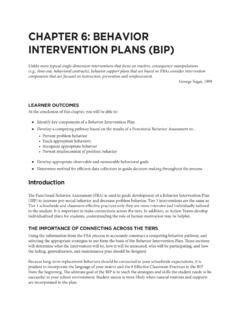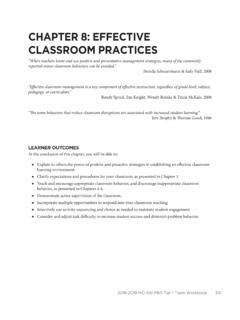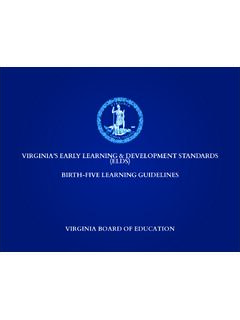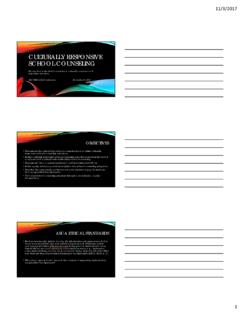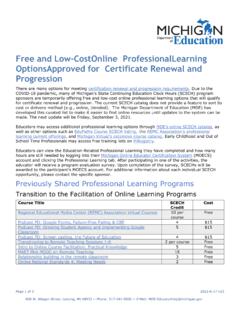Transcription of Developing Culturally Responsive Lesson Plans
1 1 Developing Culturally ResponsiveLesson Plans54th Conference Exceptional ChildrenKoury Convention CenterGreensboro, North CarolinaDr. Cathy D. KeaDr. Gloria D. Campbell-WhatleyNorth Carolina A&T State UniversityDepartment of Special Education1601 East Market Street 202-Hodgin HallGreensboro, NC 27411(336) 334-7847 ext. University of North Carolina at Charlotte Department of Counseling, SpecialEducation, and Child Development9201 University City , NC 28223(704) Multicultural StandardsCEC Common Core Knowledge and Skills for All Entry-Level Special Educators That AddressMulticultural CompetenceStandardNumberDomain AreaStandardCC1K5 FoundationsIssues in definition and identification of individuals withexceptional learning needs, including those from Culturally andlinguistically diverse points of view and contribution of Culturally and dominant culture on shaping schools and the individualswho study and work in impact of differences in values, language.
2 And customsthat can exist between the home and andCharacteristics ofLearnersCharacteristics and effects of the cultural and environmental milieuof the individual with exceptional learning needs and the LearningDifferencesImpact of learners' academic and social abilities, attitudes, interests,and values on instruction and career LearningDifferencesVariations in beliefs, traditions, and values across and withincultures and their effects on relationships among individuals withexceptional learning needs, family, and LearningDifferencesCultural perspectives influencing the relationships among families,schools.
3 And communities as related to LearningDifferencesDiffering ways of learning of individuals with exceptional learningneeds including those from Culturally diverse backgrounds andstrategies for addressing these differencesCC5K4 LearningEnvironment andSocial InteractionsTeacher attitudes and behaviors that influence behavior ofindividuals with exceptional learning andSocial InteractionsStrategies for preparing individuals to live harmoniously andproductively in a Culturally diverse andSocial InteractionsWays to create learning environments that allow individuals toretain and appreciate their own and each other's respective languageand cultural andSocial InteractionsWays specific cultures are negatively andSocial InteractionsStrategies used by diverse populations to cope with a legacy offormer and continuing andSocial InteractionsCreate a safe, equitable, positive, and supportive learningenvironment in which diversities are andSocial InteractionsOrganize, develop.
4 And sustain learning environments that supportpositive intracultural and intercultural Environmentand SocialInteractionsMediate controversial intercultural issues among students withinthe learning environment in ways that enhance any culture, group,or of cultural and linguistic differences on growth of one's own cultural and use of language and theways in which these can differ from other cultures and uses of behaving and communicating among cultures that canlead to misinterpretation and communication strategies and resources to facilitateunderstanding of subject matter for students whose primarylanguage is not the dominant PlanningDevelop and select instructional content, resources, and strategiesthat respond to cultural, linguistic.
5 And gender PlanningPrepare individuals to exhibit self-enhancing behavior in responseto societal attitudes and nonbiased formal and informal assessment information in making eligibility, program, andplacement decisions for individuals with exceptional learningneeds, including those from Culturally and/or linguistically andEthical PracticePersonal cultural biases and differences that affect one's andEthical PracticeDemonstrate sensitivity for the culture, language, religion, gender,disability, socio-economic status, and sexual orientation Responsive factors that promote effectivecommunication and collaboration with individuals withexceptional learning needs, families, school personnel, andcommunity effectively with families of individuals withexceptional learning needs from diverse Design&Delivery5 Self-Audit Of Your Culturally CompetentClassroomEnvironmental Style:1 SeekingUnderstanding3 Starting to putinto practice5 Makingcorrections/culturallyresponsive1.
6 Are your visuals representative of all culturalgroups?2. Do you have learning centers that capitalize andfocus on the different modalities/intelligences?3. Do you establish a routine and daily schedule, toprovide some important structure?4. Do you encourage interpersonal interactions and asense of family and community?5. How would you rate your understanding of thecultural ways of thinking, acting and believing of thefollowing groups? (1=low; 3=average; 5=high)African AmericansAmerican IndiansGerman AmericansHispanic/Latino AmericansHmong AmericansItalian AmericansMexican AmericansInteractional Style:1 Never3 Sometimes5 Always1.
7 When you use cooperative groups, are you certaineveryone understands their role in the performance ofthe task?2. Are you prone to heterogeneously group by race,gender and ability unless the task specificallydemands another type of grouping?3. Do you find ways to engage all students in eachlesson?4. Do you encourage formality with role definitionsand appropriate etiquette?5. Do you allow students to help each other or towork together even when reading text?Instructional Strategies for Cognitive Style:1 Never3 Sometimes5 Always1. When giving an assignment, do you provide a globalview of the task as well as a step-by-step plan for whatgroups or individuals are to accomplish?
8 6groups or individuals are to accomplish?2. Do you operate in the classroom as a guide andfacilitator rather than a performer in front of anaudience?3. Does engagement mean more to you than asking andresponding to questions or worksheets?4. Do you model and schedule opportunities to practicethe ideas or concepts before you require students todemonstrate or test their understanding?5. If you use lectures to convey information, do youlimit your presentation to 5-10 minutes and have visualsand examples as models of the concept about which youare speaking?6. Do you plan ways of helping students process andinternalize the information that has been presented?
9 7. When you use films, videos, guest speakers, orlengthy readings, do you design ways to assist studentsto think about and understand the information?Instructional Design for Cognitive StyleResponsiveness:1 Never3 Sometimes5 Always1. Do you have each day/ Lesson carefully planned?2. Do you plan a Lesson or unit with specific activities,themes, or concepts that includematerialor informationto demonstrate connectionsacross disciplines?3. Do you use the knowledge of fine arts (art, music,literature) as other ways in which students can gainknowledge about concepts or ideas?
10 Assessment Style1 Never3 Sometimes5 Always1. Do you include both qualitative and quantitative datain you assessment of individuals? Your class? Yourselfas a teacher?2. Have you analyzed the tests given you or the schooldistrict to ensure that the questions have an assumptionof knowledge with which students are familiar or ofwhich they will become familiar through yourinstruction?Source: Shade, , Kelly, C., & Oberg, M. (1998). Creating Culturally Responsive Classrooms. Washington, : American Psychological Responsive MathematicsLesson PlanSubject area: Geometry Group:Grades K-4 Date: 3/31/04 Objective: The student will: (1) Identify and compare symbols and shapes common to their lives.
